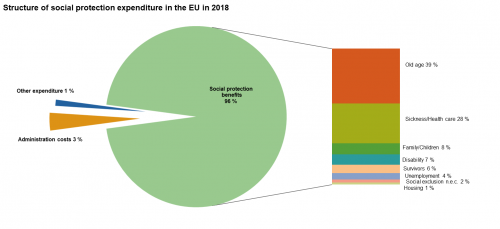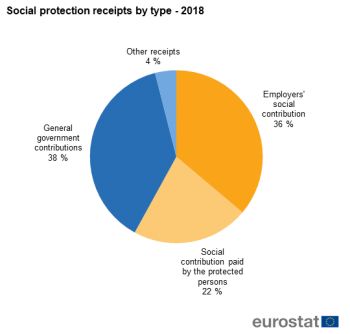Social protection statistics - background
Social protection systems are highly developed in the European Union (EU): they are designed to protect people against the risks associated with unemployment, parental responsibilities, sickness/health care and disability, the loss of a spouse or parent, old age, housing and social exclusion.
Member States are responsible for organising and financing social protection systems within their borders. The models vary from country to country, while the EU seeks to ensure that people who move across borders continue to receive adequate protection.
The European Pillar of Social Rights sets out a number of key principles and rights to support fair and well-functioning labour markets and welfare systems. The pillar contains three main categories for action, one of which concerns social protection and inclusion. This includes access to social protection benefits and good quality services, including childcare, healthcare and long-term care, which are essential to ensure a dignified living and protection against life's risks.
This article explains the main indicators used to measure social protection - expenditures, receipts and benefits - and how each is calculated.
Full article
European system of integrated social protection statistics (ESSPROS)
Data on expenditure and receipts of social protection are drawn up according to the European system of integrated social protection statistics (ESSPROS) methodology. ESSPROS was jointly developed in the late 1970s by Eurostat and representatives of the Member States in response to the need for a specific instrument for statistical observation of social protection in the EU Member States.
ESSPROS is a common framework which allows international comparison of administrative national data on social protection. It provides a coherent comparison between European countries of social benefits to households and their financing. In April 2007, a legal basis was established for the provision of ESSPROS data (with data delivery due to start in 2008 with reference to 2006 data); this basis is provided for by Regulation 458/2007.
ESSPROS is composed of the core system and of modules. The core system contains annual data (starting from the year 1990) collected by Eurostat on:
- Quantitative data: social protection receipts and expenditures by schemes (a distinct body of rules, supported by one or more institutional units, governing the provision of social protection benefits and their financing).
- Qualitative data: metadata by scheme and detailed benefit.
The modules contain supplementary statistical information on particular aspects of social protection: they relate to the beneficiaries of pensions and to net social benefits. Each module has its own methodology based on a specific Commission regulation.
Social protection expenditure
Social protection encompasses all interventions from public or private bodies intended to relieve households and individuals of the burden of a defined set of risks or needs, associated with old age, sickness and/or healthcare, childbearing and family, disability, unemployment, etc. Expenditure on social protection includes social benefits, which consist of transfers, in cash or in kind, to households and individuals to relieve them of the burden of a defined set of risks or needs; administration costs, which represent the costs charged to the social protection scheme for its management and administration; and other expenditure, which consists of miscellaneous expenditure by social protection schemes (payment of property income and other).
The structure of social protection expenditure
Figure 1 presents the structure of total expenditure on social protection for the EU in 2018. It shows the relative importance of each of its components: social protection benefits, administration costs and other expenditure. Social protection benefits are by far the largest component of social protection expenditure, totalling 96 %.
Social protection benefits are transfers to individuals aimed to provide cover against a set of eight risks/needs, which in the ESSPROS Manual are named ‘functions’. Expenditure on benefits goes to areas that either are not particularly affected by the economic situation (such as health benefits and old-age and survivors pensions) or are in fact counter-cyclical (unemployment or social exclusion benefits). Figure 1 shows on the right the weight of each of the eight functions in relation to total expenditure.
Social protection receipts
The various schemes responsible for providing social protection are financed in different ways. Social protection receipts comprise social security contributions paid by employers and protected people, contributions by general government, and other receipts from a variety of sources (for example, interest, dividends, rent and claims against third parties). Figure 2 shows the distribution of receipts by type for the EU in 2018. Social contributions by employers are all costs incurred by employers to secure entitlement to social benefits for their employees, former employees and their dependents. They can be paid by resident or non-resident employers and include all payments by employers to social protection institutions (actual contributions) and social benefits paid directly by employers to employees (imputed contributions). Social contributions made by protected people comprise contributions paid by employees, by the self-employed and by pensioners and other people.
Social protection benefits
Social protection benefits are direct transfers, in cash or in kind, by social protection schemes to households and individuals to relieve them of the burden of one or more of the defined distinct risks or needs; benefits via the fiscal system are excluded. Social benefits are paid to households by social security funds, other government units, non-profit institutions serving households (NPISHs), employers administering unfunded social insurance schemes, insurance enterprises or other institutional units administering privately funded social insurance schemes. Benefits are classified according to eight social protection functions (which represent a set of risks or needs):
- sickness/healthcare benefits – including paid sick leave, medical care and provision of pharmaceutical products;
- disability benefits – including disability pensions and the provision of goods and services (other than medical care) to the disabled;
- old age benefits – including old age pensions and the provision of goods and services (other than medical care) to the elderly;
- survivors’ benefits – including income maintenance and support in connection with the death of a family member, such as survivors’ pensions;
- family/children benefits – including support (except healthcare) in connection with the costs of pregnancy, childbirth, childbearing and caring for other family members;
- unemployment benefits – including vocational training financed by public agencies;
- housing benefits – including interventions by public authorities to help households meet the cost of housing;
- social exclusion not elsewhere classified benefits – including income support, rehabilitation of alcohol and drug abusers and other miscellaneous benefits (except healthcare).
The pensions aggregate comprises part of periodic cash benefits under the disability, old age, survivors and unemployment functions. It is defined as the sum of the following social benefits: disability pension, early-retirement benefit due to reduced capacity to work, old age pension, anticipated old age pension, partial pension, survivors’ pension, early-retirement benefit for labour market reasons. A separate module provides the number of recipients for each category of pension, with a breakdown by sex.
Expenditure on care for the elderly is a specific subgroup of old age benefits including care allowance, accommodation and assistance in carrying out daily tasks.
Net social protection benefits measure expenditure on social protection benefits less the taxes and social contributions paid on these benefits. This module estimates the amount effectively disbursed in a country for social protection benefits and leads to a more reliable among countries comparison of expenditure on social protection.
Data sources
Figures are collected from national statistical institutes or/and ministries of social affairs. Most of the data are compiled from administrative sources. More detailed information can be found in the consolidated quality reports.
The receipts of social protection schemes are classified by type and origin. The type gives the nature of, or the reason for a payment: social contributions, general government contributions, transfers from other schemes and other receipts - the origin specifies the institutional sector from which the payment is received: all resident institutional units (corporations, general government, households, and non-profit institutions serving households) and the rest of the world.
The expenditure of social protection is classified by type, indicating the nature of, or the reason for, the expenditure: social protection benefits, administration costs, transfers to other schemes and other expenditure.
Social protection benefits are transfers to households, in cash or in kind, intended to relieve them from the financial burden of a number of risks or needs. The risks or needs of social protection included in ESSPROS are disability, sickness/healthcare, old age, survivors, family/children, unemployment, housing and social exclusion not elsewhere classified.
The concept of a ‘pension’ used in the ESSPROS framework is defined as periodic cash payments that address long-term risks or needs through income replacement in case of full or partial withdrawal from, or inability to participate in, the labour market. These are intended to provide the means to support a minimum standard of living and are clearly distinguished from ‘allowances’ that cover additional costs associated with old age and/or sickness or disability (e.g. the need for long-term care).
ESSPROS identifies seven distinct types of pensions. Data on these are reported according to a two-tier classification system. The first-level breakdown classifies pensions according to four different ESSPROS functions: disability, old age, survivors and unemployment. A more detailed second-level breakdown distinguishes between different types of pensions within each category.
The annual data collection for the module on pensions' beneficiaries was launched in 2008. The aim of this module is to calculate the total number of beneficiaries within:
- Each of the previously mentioned seven categories of pensions;
- Each of the four functions grouping these categories (disability, old-age, survivors' and unemployment);
- and, at total level, for the aggregation of the four functions.
In general, the number of pensions received by pensioners differs from the number of pensioners as many pensioners might receive more than one pension. The total number of beneficiaries is, so, defined as the number of persons receiving at least one pension (i.e. a person who receives more than one pension is counted only once).
The ESSPROS module on net social protection benefits (restricted approach) measures net expenditure by collecting information on the average rates of taxes and social contributions paid by recipients of each cash benefit reported in the Core system. The collection is undertaken according to the ‘restricted approach’, which means that it is strictly limited to measuring the impact of the fiscal system on the gross cash benefits reported in the ESSPROS core system (benefits in kind are not covered). The first formal data collection for net social protection expenditure took place in 2012 for the reference year 2010.
Direct access to
- Social protection (spr), see:
- Social protection expenditure (spr_expend)
- Social protection receipts (spr_receipts)
- Pensions beneficiaries (spr_pension)
- Net social protection benefits (spr_net_ben)
- Share of EU GDP spent on social protection slightly down — News release — 22 November 2019
- How much is spent on family benefits in the EU? — Eurostat news — 1 June 2020
- Regulation (EC) No 458/2007 of 25/04/2007 on the European system of integrated social protection statistics (ESSPROS) (Summary)
- Regulation (EC) No 1322/2007 of 12/11/2007 on appropriate formats for transmission, results to be transmitted and criteria for measuring quality for the ESSPROS core system and the module on pension beneficiaries
- Regulation (EC) No10/2008 on definitions, detailed classifications and updating of the rules for dissemination for the ESSPROS core system and the module on pension beneficiaries
- Commission Regulation (EU) No 110/2011 of 8 February 2011 concerning the appropriate formats for the transmission of data, the results to be transmitted and the criteria for measuring quality for the ESSPROS module on net social protection benefits.
- Commission Regulation (EU) No 263/2011 of 17 March 2011 concerning the launch of full data collection for the ESSPROS module on net social protection benefits.


